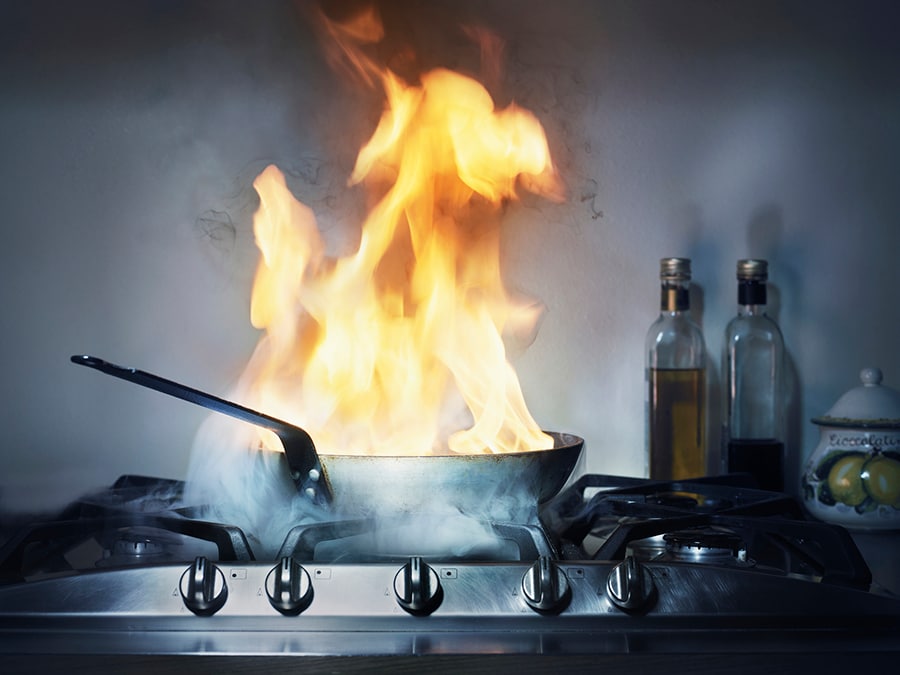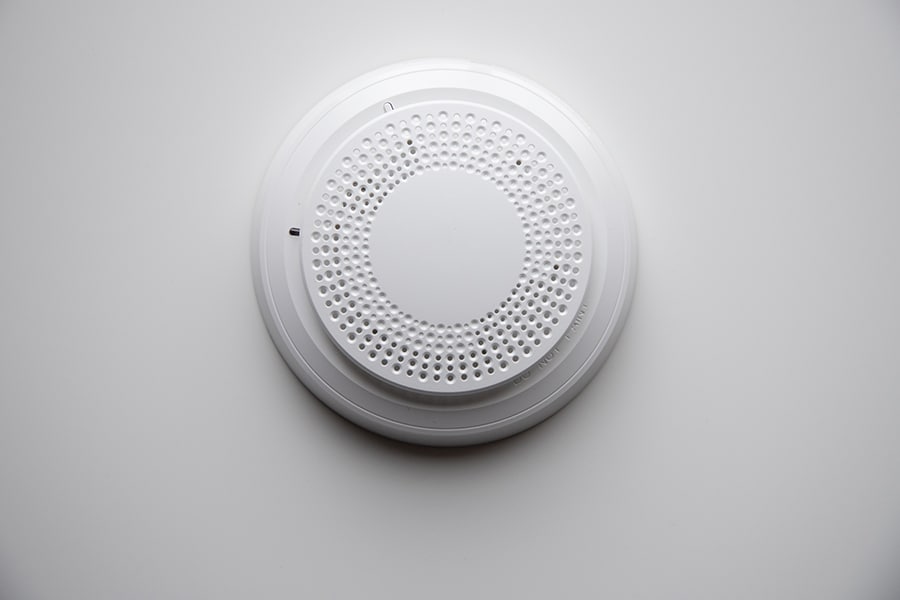From 2015 to 2019, cooking fires were the leading cause of fire-related home injuries and home fires. These fires caused 169,400 home fires, 540 civilian deaths, 4,670 civilian injuries and $1.2 billion in property damages every year.
Kitchen safety is an integral part of cooking and should always be observed—especially around cooking fires.
So, what is grease?
Grease comes in two primary forms: Machinery grease and grease from fats.
1. Lubricant grease is typically made of synthetic materials composed of a liquid and thickener. Its primary purpose is to seal leaks.
2. Kitchen grease is produced when you cook fats like butter or bacon, or when you extract oils from plant matter to create something like vegetable oil. This grease can accumulate inside pans or an oven, especially if you don’t adhere to a cleaning schedule.
We’ll go over how to put out a grease fire quickly and safely. Plus, we’ll even talk about a few kitchen ingredients you likely have on hand that can help put out small grease fires.
When does grease catch fire?
Industrial lubricant grease isn’t flammable, but kitchen grease can be combustible. Different types of cooking oils have other smoking points. Grease fires can happen when the oil you’re cooking with becomes too hot. The oil will boil, start smoke, and finally catch fire.
Smoke Point Index for Common Cooking Fats
Extra-Virgin Olive Oil |
350°F |
Butter |
350°F |
Lard |
370°F |
Vegetable oil |
400°F |
Canola Oil |
400°F |
Peanut Oil |
450°F |
Safflower oil |
450°F |
Source: Cooking with Fats and Oils: Can they withstand the heat?, April 2019
Why are grease fires so dangerous?
All fires are dangerous and should be dealt with immediately. If you cannot successfully extinguish a flame, it’s essential to leave your home and call 911. The safety of you and your family is more important than anything else.
Grease residue comes from built-up layers of grease and is found:
- On your walls or counters
- On exhaust system vents
- As built-up residue inside pots or pans
- Inside your oven
Grease fires can also start from a fire on your stovetop, then spread to other parts of your kitchen where grease splatters are. It’s essential to keep your kitchen clean and regularly de-grease or clean surfaces where grease builds up.
Grease catching fire on your stovetop.
Grease fires can do significant damage to you or your home, igniting other combustible items in the kitchen and extending into other parts of your home and eventually become life-threatening.
When you keep equipment clean, the kitchen is safer. Follow a regular cleaning schedule for walls and work surfaces.


How to put out a grease fire
When confronted with a small grease fire, you may be able to smother it before it gets out of control. If the fire is spreading, or you’re unable to contain it, immediately retreat and call 911.
Since a fire extinguisher will contaminate your entire kitchen, you should only use one as a last resort. Grease fires are considered Class B or Class K fires and should only be extinguished with an appropriate fire extinguisher.
Do’s and don’ts of putting out a small grease fire
Turn off the burner as soon as possible. It’s also a good idea to put on oven mitts when dealing with a grease fire to help protect your hands.
- Slide a metal lid or cookie sheet over the fire. A tight-fitting lid will remove the oxygen the flame needs to survive. Leave the lid or cookie sheet on the fire until the metal is cool and the fire is out.'
- Smother the grease fire with another pan that nestles inside the pan on the stovetop. Like the lid method, this removes the oxygen and keeps the fire from spreading.
- Pour baking soda or salt onto the fire. This method works best for a small fire, since you’ll need enough salt or baking soda to cover the fire completely.
- You can always spray the fire with a Class B or Class K fire extinguisher, though this should be a last resort since it will contaminate your kitchen.
Pro-tip: Only use a metal lid since a glass lid may shatter.
If the fire is large or you can’t contain it, you should immediately leave the residence and call the fire department.
Don’ts of putting out a grease fire:
- Don’t extinguish a grease fire with water or a wet towel.
- Don’t use flour, baking powder or sugar to smother the fire.
- Don’t remove the pan from the burner or place it in the sink. The oil may splash around and potentially burn you.
- Don’t move the pan into the sink, even if the fire is smothered.
- Don’t remove the lid from the pan. Removing it may cause the fire to re-ignite.
If the fire is too big and you can’t put it out, leave your home and call 911. Keep the door closed as you exit to help contain the fire.


Fire extinguisher and smoke detector safety tips
Using the correct fire extinguisher in your home is key to putting out a fire.
According to the National Fire Protection Agency (NFPA), you should:
- Have a multipurpose extinguisher large enough to put out a small home fire, but lightweight enough for you to handle.
- Make sure the fire extinguisher has been independently tested.
- Place your fire extinguishers near an exit or on the way out of the building. If the fire gets out of control, you may have to evacuate.
- Read the manufacturer’s instructions and know how to handle a fire extinguisher.
- Practice your fire escape plan so you’ll be prepared if a fire does happen in your home.
Pro-tip: Many local fire departments offer demonstrations and hands-on training for proper fire extinguisher usage. Contact your local fire department and see if they offer classes.
Different Kinds of Fire Extinguishers
Type of Fire Extinguisher |
What it’s Used For |
Class A |
Ordinary combustibles like wood, cloth, plastic or paper. |
Class B |
Combustible liquids, gasses, grease, oil, gasoline, alcohol or propane. |
Class C |
Electrical fires from appliances, tools or wires. |
Class D |
Flammable metals such as titanium, sodium, magnesium or potassium. |
Class K |
Vegetable-based oils and animal fats used in cooking. |
Multipurpose BC |
Flammable liquids, gasses or electrical fires. They are designed to extinguish B and C fires. |
Multipurpose ABC |
Fires that involve ordinary combustibles, flammable liquids, gasses or electrical equipment. They are designed to extinguish A, B, and C fires. |
What kinds of fire alarms are there?
There are two main types of fire alarms: ionization alarms and photoelectric alarms.
An ionization alarm is typically the most common type of alarm and is more responsive to flaming fires, such as a pan or grease fire.
Photoelectric smoke alarms sense smoldering fires. For example, a smoldering fire can occur if someone drops a cigarette on a mattress.
The NFPA recommends you choose an alarm that combines these two types of sensors for the best fire coverage.
ADT’s fire alarms feature this kind of combination smoke detector technology.


Where should you put a fire alarm?
The NFPA requires fire alarms in certain instances and areas, such as
- You should install at least one on every level of your home, including the basement.
- Place one in every bedroom or sleeping place.
- A smoke alarm should be outside every room, such as a hallway.
- If you have a floor that doesn’t have a bedroom, you should still install the fire detector near the stairs or in the living room.
- Place a smoke detector at least 10 feet from any cooking appliances in the kitchen to reduce false alarms.
What happens when you use water on a grease fire?
Grease fires can happen in the blink of an eye. You should never try to use water on a grease fire or move the pan into the sink where water might be. Introducing water to a grease fire causes it to splash and spread, potentially causing more significant injury.
Oil has less density than water. So, when you pour water over a grease fire, the water sinks beneath the grease. That causes the grease to move to the surface of a pan, where it vaporizes and turns into steam.
As the water turns into steam, it rapidly expands, sending hot oil out of the pan and into a ball of exploding grease. Since this oil is already on fire, it essentially explodes.
What happens when you pour flour on a grease fire?
Flour doesn’t smother a grease fire. In fact, flour is flammable and might explode if introduced to a grease fire. Never, under any circumstances, should you try to smother a grease fire with flour or other baking mixes.
What happens when you pour sugar on a grease fire?
Throwing sugar on a grease fire will not extinguish it. The sugar will melt and caramelize, causing the fire to spread. If you try to use powdered sugar, the fire might explode, similar to how it reacts if you introduce fire to flour.
How do I clean up after a grease fire?
Soot and grease can be difficult to clean. Just because the smoke has dissipated, doesn’t mean that there isn’t lasting smoke damage. Sometimes smoke particles can even seep into your walls or HVAC system or vents.
Smoke particles can also linger in upholstery or other porous items. You can clean or sanitize some of these items, but others may need professional cleaning or repair.
- Carpet
- Wooden or upholstered furniture
- Curtains
- Clothing
- Drywall
- Wallpaper
- Plastic food containers or mixing bowls
- Nonperishable food in plastic
Even food in glass or aluminum can become contaminated. If you have any doubt about smoke contamination, you should throw the item out or speak to fire restoration professionals. They can clean and decontaminate salvageable items.
Is the smoke from a grease fire toxic?
The smoke produced from a fire can contain many byproducts—including tar or other contaminants—and can be incredibly toxic. Long-term exposure to smoke particles could lead to increased cardiovascular diseases or other complications, especially if you have pre-existing health issues.
Fine or lingering smoke particles could irritate your sinuses or lungs and higher or prolonged concentrations can lead to more serious symptoms.
- Difficulty breathing or coughing
- Skin irritation
- Trouble fighting off future viruses
Immediately seek help if you believe you or your loved ones are experiencing symptoms from lingering smoke particles.
12 more grease fire safety tips
The best way to help prevent a grease fire is to monitor your oil while cooking and turn the burner off if you leave the room.
Here are a few more tips to help prevent fires from starting in your kitchen.
1. Remove moisture from your food before cooking by blotting them with paper towels.
2. Use a slotted spoon to add food into the oil to prevent splatter.
3. If your cooking oil starts is excessively smoking, turn the heat down or remove the pan from the burner.
4. Do not leave children unattended with hot appliances or an open flame.
5. Have the pan’s lid nearby so you can quickly extinguish any flames.
6. Make sure you periodically clean your stovetop and the interior of your stove to prevent grease buildup.
7. Keep long hair, dangling jewelry and long sleeves out of the way when cooking.
8. Always have a class B, K or a multipurpose fire extinguisher nearby.
9. Position pot handles away from you, towards the back of the stove, to help prevent the handles from being jostled.
10. Install fire alarms in your home and annually check that they’re working.
11. If you have a turkey fryer, only use it according to its instructions.
12. Keep flammable items away from your stove, including spices, dishtowels and grocery bags.
ADT’s fire alarms offer fast fire detection when every second counts.
Smoke detectors and fire alarms are critical to protecting your home and family. Our 24/7 monitoring centers notify both you and the fire department when there’s smoke.
Call today to see how you can help protect your home with a fire protection system with ADT.
Frequently Asked Questions about Grease Fires
Will salt extinguish a grease fire?
Yes, salt will extinguish a small grease fire. However, you will need a lot of salt to do this—think of several handfuls. You should only attempt this method on small fires.
Can you put out a grease fire with flour?
Flour will not smother a grease fire. In fact, flour is flammable and might explode if introduced to a grease fire. Never, under any circumstances, should you try to smother a grease fire with flour or other baking mixes.
What happens if you try to use baking powder on a grease fire?
While baking soda can extinguish a fire, baking powder can make the fire worse. You should also avoid using flour or baking mixes that use either of these ingredients.
Can you put a wet towel on a grease fire?
You should never, under any circumstances, try to put out a grease fire with anything containing water–even a wet towel. This could cause the fire to splatter and spread. Instead, try to smother the flames with a tightly fitting (metal) lid or cookie sheet.
Can a grease fire explode?
Yes, grease fires can explode if they encounter water particles. When this happens, the water sinks below the grease and goes right to the heat source. The water molecules turn to steam, then explode.
Related Articles:


